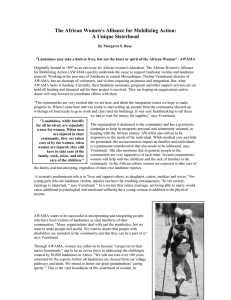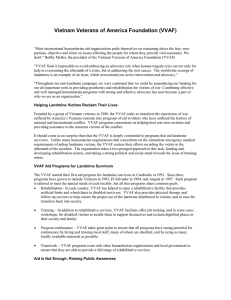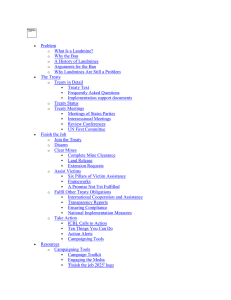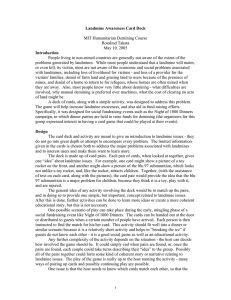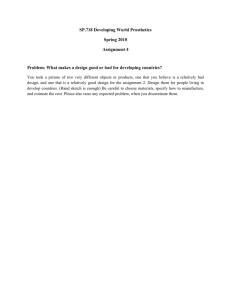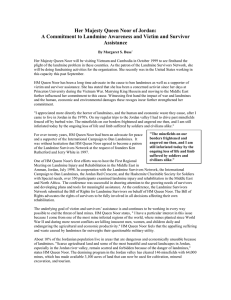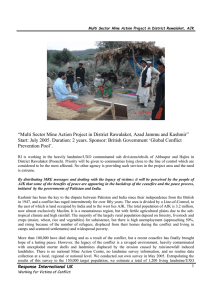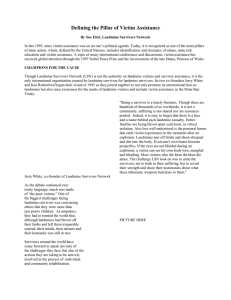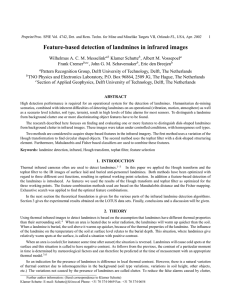Resourcing Mercy Across Borders by Maureen Morton
advertisement
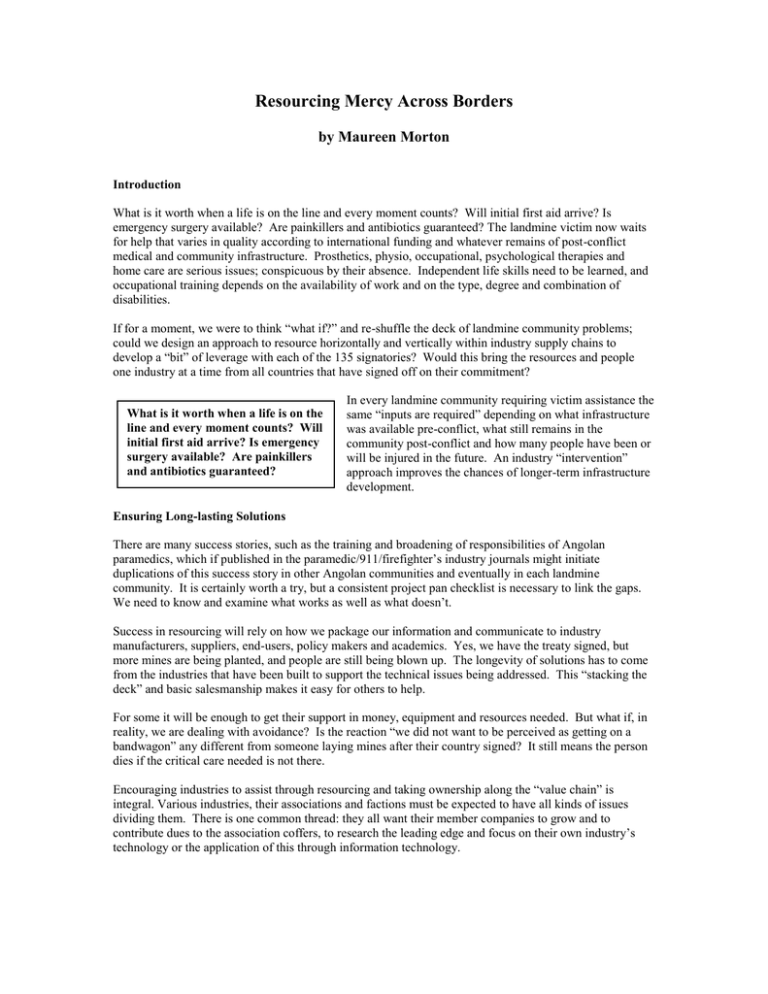
Resourcing Mercy Across Borders by Maureen Morton Introduction What is it worth when a life is on the line and every moment counts? Will initial first aid arrive? Is emergency surgery available? Are painkillers and antibiotics guaranteed? The landmine victim now waits for help that varies in quality according to international funding and whatever remains of post-conflict medical and community infrastructure. Prosthetics, physio, occupational, psychological therapies and home care are serious issues; conspicuous by their absence. Independent life skills need to be learned, and occupational training depends on the availability of work and on the type, degree and combination of disabilities. If for a moment, we were to think “what if?” and re-shuffle the deck of landmine community problems; could we design an approach to resource horizontally and vertically within industry supply chains to develop a “bit” of leverage with each of the 135 signatories? Would this bring the resources and people one industry at a time from all countries that have signed off on their commitment? What is it worth when a life is on the line and every moment counts? Will initial first aid arrive? Is emergency surgery available? Are painkillers and antibiotics guaranteed? In every landmine community requiring victim assistance the same “inputs are required” depending on what infrastructure was available pre-conflict, what still remains in the community post-conflict and how many people have been or will be injured in the future. An industry “intervention” approach improves the chances of longer-term infrastructure development. Ensuring Long-lasting Solutions There are many success stories, such as the training and broadening of responsibilities of Angolan paramedics, which if published in the paramedic/911/firefighter’s industry journals might initiate duplications of this success story in other Angolan communities and eventually in each landmine community. It is certainly worth a try, but a consistent project pan checklist is necessary to link the gaps. We need to know and examine what works as well as what doesn’t. Success in resourcing will rely on how we package our information and communicate to industry manufacturers, suppliers, end-users, policy makers and academics. Yes, we have the treaty signed, but more mines are being planted, and people are still being blown up. The longevity of solutions has to come from the industries that have been built to support the technical issues being addressed. This “stacking the deck” and basic salesmanship makes it easy for others to help. For some it will be enough to get their support in money, equipment and resources needed. But what if, in reality, we are dealing with avoidance? Is the reaction “we did not want to be perceived as getting on a bandwagon” any different from someone laying mines after their country signed? It still means the person dies if the critical care needed is not there. Encouraging industries to assist through resourcing and taking ownership along the “value chain” is integral. Various industries, their associations and factions must be expected to have all kinds of issues dividing them. There is one common thread: they all want their member companies to grow and to contribute dues to the association coffers, to research the leading edge and focus on their own industry’s technology or the application of this through information technology. Solution Logistics If the communication tool used is the need for mobile How do we provide the range of clinics and the equipment to stock them, then options healthcare and rehabilitation services, may open up. Initially the goal of one vehicle from sustainable development and real jobs each country, whether a signatory or not, should be for the landmine victims and their attainable. Industries could “sponsor” in line with their families? expertise. A fleet of 190 vehicles would test the potential applications of surgical theatres, prosthetics workshops, physio, occupational and psychological therapies, home care and job training. Each clinic would make “milk runs” through a specified region that is determined by greatest need due to lack of availability of medical services. In developed countries many prototypes exist: surgical theatres (airborne), prosthetics workshops (Terry Fox mobile), CAT, MRI and PET scanning. These setups offer a versatility of patient services to communities unable to afford their own infrastructure of building and staff. If industry professionals begin to take “ownership” and apply answers to problems already solved in developed countries, where their patients have already developed functional and tactical skills to living with a particular disability; then the Landmine industry goal of returning a person to a pre-injury lifestyle may be attainable. Facilitating Aid A resourcing problem across all industries; on corporate, philanthropic, regional and local levels, is the laws and policies that keep potential donors from participating in the aid effort. What international, country, provincial/state, or corporate laws/policies need to be modified to facilitate the help required in the field and in the clinics? How do we provide the range of healthcare and rehabilitation services, sustainable development and real jobs for the landmine victims and their families? Ex: What changes to tax laws by each signatory country are required to allow surplus medical equipment to be shipped, with government support and tax incentives, to communities in need? As a challenge to the law students: What laws in what countries are causing bottlenecks and who is willing to analyze the legal bottlenecks to facilitate support? What landmine database could accommodate the identification of these laws and the difficulties they cause, and present amendments to facilitate aid? Where does this information currently reside? What are the legal impediments within each industry value chain and how can they be modified to accommodate the empathy of the developed world’s technicians and practitioners? Ex: A prosthetist understands the value of a good grinder and may wish to donate via a tax benefit his old equipment when it is replaced. Are the tax programs in place and are the bar coding systems being used to get this equipment to its destination workshop? Referencing the problem of orthotic braces in Cambodia, what legal barriers are preventing the international orthotics and prosthetics industries from lending the true support required? From a Business Perspective Are associations willing to analyze their value chain to increase and direct the appropriate resources to help this effort? Are industry suppliers willing to analyze their value chain to increase and direct the appropriate resources to help this effort? Ex: Would the airline industry allow their clients to donate frequent flyer points to facilitate travel for medical and demining staff, or for patients who need advanced medical care not available in their home communities? Could the points be used to cover the freight cost to ship equipment or buy fuel to ship donated heavy equipment? From an individual’s perspective These may be difficult corporate policies to modify, but even frequent flyer points can become a currency to effect change; a way for the everyday person to help. If 10% of the American people wished to give more than money; if they wished to give their time and hearts, how would we accommodate their learning curve? Ex: How would we deal with professionals wishing to donate two nights a week? What multidisciplinary process can be built to accommodate this demand in other countries as well? In helping current landmine victims and preventing new ones it is not enough to stop after one attempt at aid. The process of helping victims can always be improved upon; especially with today’s newest technology. The resources we need are available, but it is up to us to harness them and make them work for those who truly need help. Maureen Morton: Maureen Morton brings a wide background of experience and commitment to the landmines industry, including an earlier career as a prosthetics technician; designing, constructing and fitting a variety of prosthesis for patients of farm, traffic, war, disease and congenital amputations. Her dedication to the landmines industry began with Treaty week at the Ottawa Congress Centre, December 1997. Since this time she has engaged in market research through e-mail, conferences in the United States and in the Netherlands (International Society of Prosthetics and Orthotics ISPO 98). Before forming Project Assistance, her proprietorship, Maureen worked in a variety of industries, often with senior management, specializing in Timeline project planning as an administrative tool. Most recently she created the administrative infrastructure for the professional development program of an Executive MBA Program.
